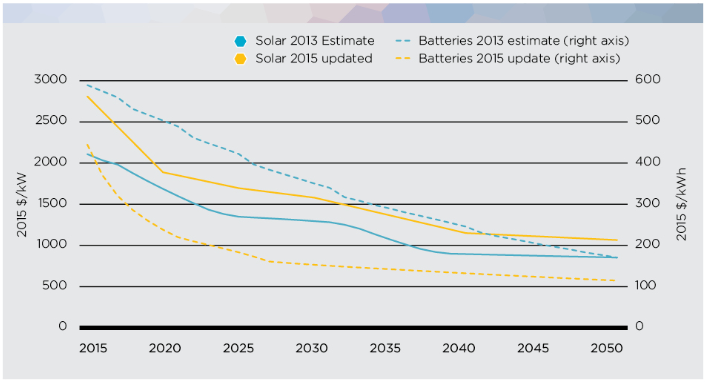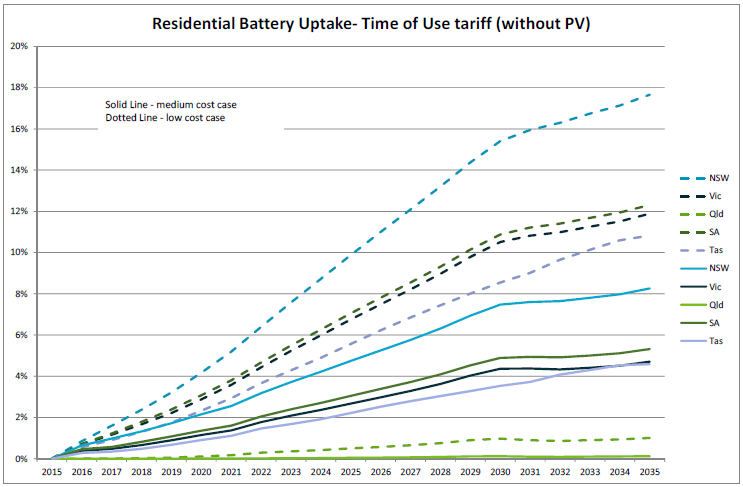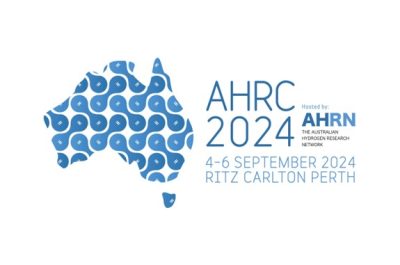Stored knowledge
The anticipated boom in battery storage technology is widely heralded as an opportunity for Australia’s energy customers and the energy system itself. Australia’s high penetration of grid-connected rooftop solar, and the natural progression to linking that with battery storage, can benefit the whole community when managed safely and efficiently.
While uptake rates vary based on assumptions about how quickly and to what degree battery storage costs will fall, it is widely forecast that there will be significant uptake of residential battery storage over the next 20 years. CSIRO’s Future Grid Forum in 2013, and refresh in 2015 conducted jointly with the Energy Networks Association as part of the Electricity Network Transformation Roadmap, projects battery storage cost reduction trajectories demonstrated in the chart below[1].

Figure 1: Previous (2013) and updated (2015) battery (right axis) and rooftop solar panel (left axis) projected technology costs
The falling battery cost trajectory between now and about 2030 coincides with projected strong take up of the technology, as demonstrated in Figure 2.
“For residential customers without solar PV, adding battery storage provided a much faster payback with a TOU tariff. Assuming the low‐cost battery case, adoption reaches almost 18% by 2035 in New South Wales, and just over 12% in the next best cases (i.e. South Australia and Victoria).”[2]

Figure 2: Projected adoption of battery storage for customers without solar PV under a TOU tariff[3]
As battery technologies and costs continue to improve, some commentators might suggest that even these forecasts are conservative.
That said, uptake of battery storage in Australian homes is in its infancy. Costs of battery technology need to fall further to make it economic for the average consumer[4],[5], however, Kobad Bhavnagri, Head of Australia for Bloomberg New Energy Finance, told energy leaders at Energy Networks 2016 in May that:
“…consumers look to a rational economic proposition, but they also look … they are also influenced by behavioral considerations. How well the project is marketed. Do their friends have it? Is it something that’s new and shiny that makes them feel good? … History tells us that when a technology offers a superior proposition to the consumer it eventually gets to universal uptake.”
The Electricity Network Transformation Roadmap Interim Project Report, recognises that established electricity systems are experiencing complex and unprecedented change arising from the strong adoption of distributed energy resources (DER) by customers. If integrated well, DER, including battery storage, can deliver operational benefits and efficiencies to electricity networks and long term value to energy customers, through more efficient grid utilisation.
Knowing what and where DERs are installed is vital for maximising their value to customers and efficient grid operation and investment.
The COAG Energy Council recognises the need for collecting locational knowledge and information, particularly for energy storage systems, in its Energy Storage Registration Consultation Paper. It considers that energy storage data should be collected and made available for:
- Power system planning and operation;
- Emergency response; and
- Safety and industry integrity.
The anticipated mass take-up of small-scale energy storage systems has implications for the management of the distribution network and even potentially the transmission network. Access to energy storage data and locational information by energy networks and the Australian Energy Market Operator (AEMO) will be required for the safe and reliable management of electricity networks.
Energy networks agree that an energy storage register is needed in Australia, and wish to constructively participate in the development of transparent, accessible information on storage and other forms of DER, in an efficient manner. Many of the improved planning and operational functions that will be enabled by the existence of a register are likely to be equally reliant on information on other DERs, including embedded generation, the presence of electric or gas powered vehicles, and load-switching or demand response services. It would be appropriate for the COAG Energy Council review to assess how a registration system for energy storage would coexist with, or complement, broader information requirements on DERs.
While register information should be collected in a nationally consistent format and, ideally, in a single nationally accessible platform, some questions posed in the Consultation Paper may not be able to be answered without a more substantial investigation and cost/benefit analysis developed over an appropriate timeframe.
Detailed consideration should be given to:
- What are the exact intended uses of such a register?
- What would be the ongoing cost/benefit of different host options?
- What data collection powers currently exist, or need to be provided, to ensure compliance with registration requirements?
- Who will have access to the register, and what level of data will be available to particular ‘users’?
Consideration of what information each group of users needs to undertake their activities will inform what information is collected. For example, emergency services may require relatively basic knowledge of which premises have a storage device and the battery type. AEMO may require information on capacity and types of energy storage systems on an aggregated and locational level. At the same time, with an increasingly integrated and actively managed grid, energy networks will likely require access to information at a more granular level, including detailed, feeder-specific information at NMI/meter or even phase-level.
Consideration should be given to the adequacy of existing information collection powers, as those available under connection agreements do not provide sufficient clarity about DER connected to distribution networks. This may hinder the use of DER to avoid network augmentation.
There are existing processes that collect some of this information. The Australian Energy Storage Alliance collects details of commercial and utility scale energy storage projects in Australia and New Zealand, listing details such as technology, location, ownership, and status. It, and the Australian Storage Council, are creating storage registers that may provide a substantial basis for the information register proposed in the Consultation Paper. The ENA recommends the COAG Energy Council undertake a thorough identification and review of what databases of DER, or similar information, exist prior to determining the format and hosting of a new energy storage register.
It will be important that information collected in the register is treated appropriately with respect to customers’ privacy. It may be necessary to develop and apply appropriate protections to maintain the confidentiality of certain information. Though, it is also possible that data collected in a register could be valuable, from a broader commercial or business development perspective, to parties other than electricity network businesses and AEMO. Therefore, apart from the establishment and observation of privacy rules, clear agreement must be reached on who can access the register, for what information, and what purpose.
The COAG Energy Council Energy Storage Registration Consultation Paper and process is only one lens through which the contribution of DER to the management of energy networks can be viewed. The Electricity Network Transformation Roadmap development process is evaluating the broader implications and benefits of DER in terms of regulatory frameworks, pricing and incentives, and operation of the distribution system operation.
ENA’s submission in response to the Energy Storage Registration Consultation Paper can be found here.
[1] CSIRO and Energy Networks Association 2015, Electricity Network Transformation Roadmap: Interim Program Report, p. 55, http://www.ena.asn.au/files/roadmap_interim_report_final.pdf
[2] CSIRO (September 2015) Future energy storage trends, p. 106
[3] CSIRO (September 2015) Future energy storage trends, p. 106
[4] AEMO (June 2016) National Electricity Forecasting Report, p. 31
[5] CSIRO (September 2015) Future energy storage trends, p. iv


